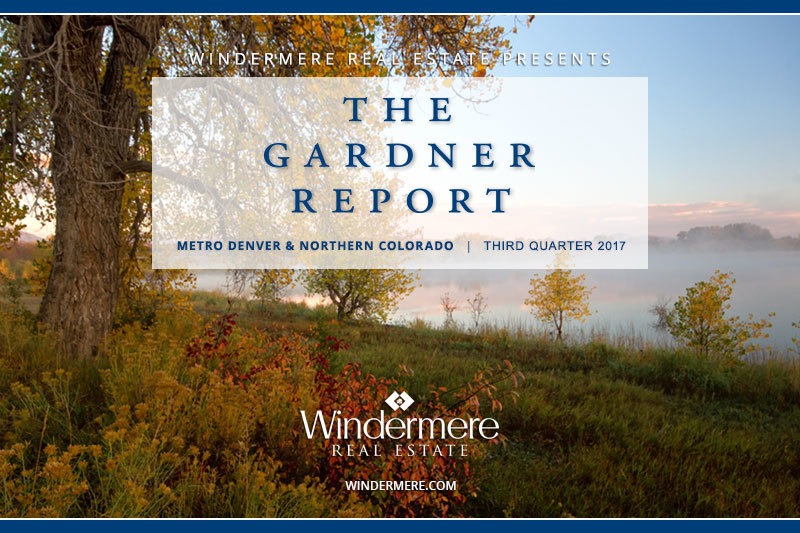Get Real

A story ran this week which highlighted the number of people who have moved out of Colorado.
Let’s get real, there are still a large number of people moving to Colorado.
In fact, 223,000 moved to Colorado from another state last year according to the latest American Community Survey from the U.S. Census Bureau.
The net migration into our state (after subtracting out people who left) was 30,859 people.
In Northern Colorado the net migration looks like this:
- Larimer County = 7,001 people
- Weld County = 7,117 people
So what does that mean for housing? Knowing that, on average, 2.5 people live in each household, the number of new housing units required for these new residents looks like this:
- Larimer County = 2,800 new housing units
- Weld County = 2,847 new housing units
New Proposed Tax Bill

House Republicans released their proposed tax bill last Thursday. The proposal is a long way from becoming law, but the draft contains three noteworthy items related to housing.
As the law stands now, homeowners can claim as an itemized deduction interest paid on mortgages valued up to $1 million used to acquire or improve a first and/or second home. The plan maintains the current cap for existing homeowners, but cuts it to $500,000 for homes purchased in the future. (The bill would also limit the mortgage interest deduction to one principal home, ending any deductions for vacation homes.)
Another change is to the provision that allows homeowners to exclude from their taxable income up to $250,000 in capital gains ($500,000 for married taxpayers) from a sale of their primary residence. Under the plan, to qualify for this break, homeowners must have owned and lived in the home for at least five of the last eight years. Currently the rule is two of the last five. Taxpayer use of the exclusion would also be limited to one sale every five years, rather than one every two. In addition, under the house bill, you begin to lose the gains exemption if adjusted gross income (in a look-back period) exceeded $500,000 if married or $250,000 if single.
The third change is the proposal to cap the deduction for property tax on a home at $10,000. Currently all state and local taxes are deductible from ordinary income.
To see an update as to what is happening in the Northern Colorado market, contact me to receive our quarterly “Scoop” report.
Colorado Real Estate Market Update


ECONOMIC OVERVIEW
Colorado added 45,800 non-agricultural jobs over the past 12 months, a growth rate of 1.8%. Within the metropolitan market areas included in this report, annual employment growth was seen in all areas other than Grand Junction (where employment was stable) with substantial growth seen in Fort Collins (4.6%) and Greeley (3.5%).
In August, the unemployment rate in the state was 2.2%, down from 3.1% a year ago. The lowest reported unemployment rates were again seen in Fort Collins at just 1.8%. The highest rate was in Grand Junction, at a very respectable 3.0%. It is still reasonable to assume that all the markets contained within this report will see above-average wage growth given the very tight labor market.
HOME SALES ACTIVITY
- There were 17,140 home sales during the third quarter of 2017, which was a drop of 3.3% from the same period in 2016.
- Sales rose the fastest in Boulder County, which saw sales grow 4% more than the third quarter of 2016. There were marginal increases in Weld and Larimer Counties. Sales fell in all the other counties contained within this report.
- Home sales slowed due to very low levels of available inventory. Listing activity continues to trend at well below historic averages, with the total number of homes for sale in the third quarter 5.5% below the level seen a year ago.
- The takeaway here is that sales growth has stalled due to the lack of homes for sale.

HOME PRICES

- With substantial competition for the few available homes, prices continue to rise. Average prices were up 7.5% year-over-year to a regional average of $428,602.
- Slower appreciation in home values was again seen in Boulder County, but the trend is still positive.
- Appreciation was strongest in Weld County, which saw prices rise 12%.
- Due to an ongoing imbalance between supply and demand, home prices will continue to appreciate at above-average rates for the foreseeable future.

DAYS ON MARKET
- The average number of days it took to sell a home dropped by one day when compared to the third quarter of 2016.
- Homes in all counties contained in this report took less than a month to sell. Adams County continues to stand out as it took an average of just two weeks to sell a home there.
- During the third quarter, it took an average of 20 days to sell a home. This is up by 3 days compared to the second quarter of this year.
- Demand remains strong, and well-positioned, well-priced homes continue to sell very quickly.

CONCLUSIONS
 This speedometer reflects the state of the region’s housing market using housing inventory, price gains, home sales, interest rates, and larger economic factors.
This speedometer reflects the state of the region’s housing market using housing inventory, price gains, home sales, interest rates, and larger economic factors.
In the third quarter of 2017, I have chosen to leave the needle where it was in the second quarter. Homes are still scarce; however, there is a small slowdown in price growth and a decline in both closed and pending sales. This may suggest the market is either getting weary of all the competition or that would-be buyers are possibly putting off buying until they see more choices in the number of homes for sale.

Matthew Gardner is the Chief Economist for Windermere Real Estate, specializing in residential market analysis, commercial/industrial market analysis, financial analysis, and land use and regional economics. He is the former Principal of Gardner Economics, and has more than 30 years of professional experience both in the U.S. and U.K.
If you are in the market to buy or sell, let me know! I am happy to help!
Short vs Long

 There are short-term questions about real estate and there are long term questions about real estate.
There are short-term questions about real estate and there are long term questions about real estate.
Clients often have short-term questions like…
How much will prices go up next year? Should I sell my house this Fall or next Spring? Will interest rates go up next week?
We encourage our clients to evaluate those questions in the context of the long-term. There are decades of data on the Northern Colorado market which reveal certain patterns.
When we show our clients these patterns they feel confident and secure in the investment they have made into their home and their rental properties.
For example, the long-term appreciation rates based on up to 41 years of research are as follows:
- Larimer County = 5.36%
- Weld County = 4.25%
- Metro Denver = 5.56%
So over the course of a year prices may go up a lot or go up a little, but in the long term they will stay true to these long term averages.
To see an update as to what is happening in the Northern Colorado market, contact me to receive our quarterly “Scoop” report.
Inventory is UP!

For the past few years the hot topic in Northern Colorado real estate is
Price Per Square Foot

At some point this weekend it’s likely you will make a stop at the local grocery store. When you are there you might  pick up some produce. That produce, as you know, is priced by the pound.
pick up some produce. That produce, as you know, is priced by the pound.
Homes, aren’t priced by the pound of course. But they are priced by the foot.
An interesting way to examine an entire real estate market or a specific home is to look at the price per square foot.
For example, right now our company has a 2,470 square foot home right on the water in Seattle listed at $4,995,000. That comes to $2,022 per square foot.
Meanwhile, we also have a 2,549 square foot home for sale in Timnath priced at $445,000 which is $175 per square foot.
Price per foot is driven by many factors the most important ones being location and finishes.
Here is the average price per foot for our main markets across Northern Colorado:
- Fort Collins = $181
- Loveland = $160
- Greeley = $126
- Windsor = $136
If you would like to know what your home is worth, per square foot, contact me and I will get that information into your hands right away.
Fall vs Spring

 A question we start to hear from clients this time of year is “am I better off waiting until the Spring to sell my home?”
A question we start to hear from clients this time of year is “am I better off waiting until the Spring to sell my home?”
The perception is that Spring is the busy time for home sales and that a Seller would be better served waiting to sell their home.
The reality is the numbers show that your odds of selling your home in the fall (and even the Winter) are just as good as the Spring. The reason is that the competition from other sellers is much lower in the Fall and Winter.
Let’s see what the numbers say…
We did an analysis of the number of homes that sold last year in each month versus the homes for sale that month and then looked at the ratio. For example, if 500 homes were for sale and 250 of them sold, the ratio would be 50%.
Here are the ratios for certain months in our 3 major Northern Colorado markets:
Fort Collins
- March = 38%
- October = 38%
- December = 55%
Loveland
- March = 39%
- October = 43%
- December = 46%
Greeley
- March = 48%
- October = 49%
- December = 82%
So the numbers tell us that there is no advantage of waiting until the Spring.
Also, all of our clients who are listing their home now see the advantage of dealing with the “known” versus the “unknown” when it comes to interest rates, demand levels and other market factors.
If you would like to see the odds of selling in your particular neighborhood and your particular price range, contact me today.
Colorado Home Price Appreciation

New Rankings
Check out the FHFA recap video here:
Here is the data straight from FHFA’s report:
U.S. house prices rose 1.6 percent in the second quarter of 2017 according to the Federal Housing Finance Agency (FHFA) House Price Index (HPI). House prices rose 6.6 percent from the second quarter of 2016 to the second quarter of 2017. FHFA’s seasonally adjusted monthly index for June was up 0.1 percent from May.
The HPI is calculated using home sales price information from mortgages sold to, or guaranteed by, Fannie Mae and Freddie Mac. FHFA has produced a video of highlights for this quarter.
Significant Findings
- Home prices rose in 48 states and the District of Columbia between the second quarter of 2016 and the second quarter of 2017. The top five states in annual appreciation were: 1) Washington 12.4 percent; 2) Colorado 10.4 percent; 3) Idaho 10.3 percent; 4) Florida 9.4 percent; and 5) Utah 9.2 percent.
- Among the 100 largest metropolitan areas in the U.S., annual price increases were greatest in the Seattle-Bellevue-Everett, WA (MSAD), where prices increased by 15.7 percent. Prices were weakest in New Haven-Milford, CT, where they rose by 0.1 percent.
- Of the nine census divisions, the Pacific division experienced the strongest increase in the second quarter, posting a 2.6 percent quarterly increase and a 8.9 percent increase since the second quarter of last year. House price appreciation was weakest in the Middle Atlantic division, where prices rose 0.8 percent from the last quarter.
Source: FHFA
Should You Wait or Buy Now?
The housing market is remarkably tight across the U.S., and you may be wondering if you should wait for home prices to slow before making your move. Windermere’s Chief Economist, Matthew Gardner, shares why waiting could end up costing you more money in the long run.
Should You Wait out the Housing Market?
The housing market is remarkably tight across the U.S., and you may be wondering if you should wait for home prices to slow before making your move. Windermere's Chief Economist, Matthew Gardner, shares why waiting could end up costing you more money in the long run.
Posted by Windermere Real Estate on Friday, August 18, 2017
 Facebook
Facebook
 Twitter
Twitter
 Pinterest
Pinterest
 Copy Link
Copy Link




